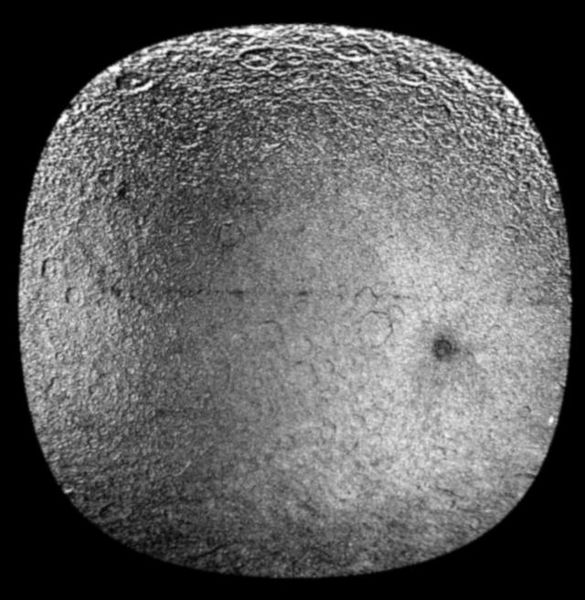Image: Rhea PIA13422 center

Description: Central img of PIA13422 "Tinted Rhea". Original caption: These three views of Saturn's moon Rhea were made from data obtained by NASA's Cassini spacecraft, enhanced to show colorful splotches and bands on the icy moon's surface. Scientists believe the reddish and bluish tints came from bombardments large and small. Icy material sprayed by the moon Enceladus hits Rhea head-on in its orbit around Saturn and leaves a coral-colored tint. Darker, rust-colored reddish hues paint the trailing hemisphere, or the side that faces backward in the moon's orbit around Saturn. The reddish hues are thought to be caused by tiny particle strikes from circulating plasma, a gas-like state of matter so hot that atoms split into an ion and an electron, in Saturn's magnetic environment. Tiny, iron-rich "nanoparticles" may also be involved, based on earlier analyses by the Cassini visual and infrared mapping spectrometer team. Rhea sports a chain of bluish splotches along the equator that appear where fresh, bluish ice has been exposed on older crater rims. Cassini imaging scientists recently reported that they did not see evidence in Cassini images of a ring around Rhea. However, scientists analyzing these enhanced-color views suggest the bluish material could have been exposed by the crash of orbiting material -- perhaps a ring -- to the surface of Rhea in the not too distant past. These images were made by processing raw images obtained by Cassini's imaging cameras in November 2005. Scientists analyzed frames shot through visible-light, ultraviolet and infrared filters. The processing enhanced our views of these moons beyond what could be seen by the human eye. The image on the left shows a composite image made from data in the infrared, green and ultraviolet filters. The middle view shows an image made from data analyzing the ratio of infrared to green wavelengths, indicating the relative redness of the features. The brighter the feature is in this middle view, the redder it is. The image on the right shows data analyzing the ratio of infrared to ultraviolet wavelengths. The darker the feature is, the bluer the tint In each of these images, the trailing hemisphere is on the left side and leading hemisphere is on the right side. They are centered near 145 degrees west longitude, about 35 degrees east of the boundary between the leading and trailing hemispheres. The bright crater Inktomi can be seen near the center of the images on the left and right, but was more difficult to see in the middle image because of there is less contrast in the infrared/ultraviolet ratio.
Title: Rhea PIA13422 center
Credit: NASA/JPL
Author: Cassini
Usage Terms: Public domain
License: PD
Attribution Required?: No
Image usage
The following page links to this image:

